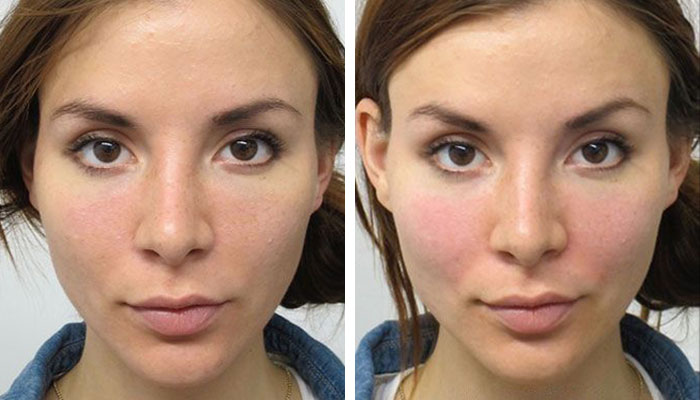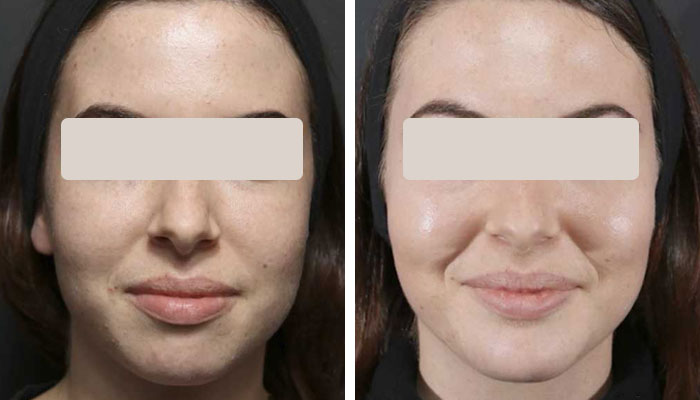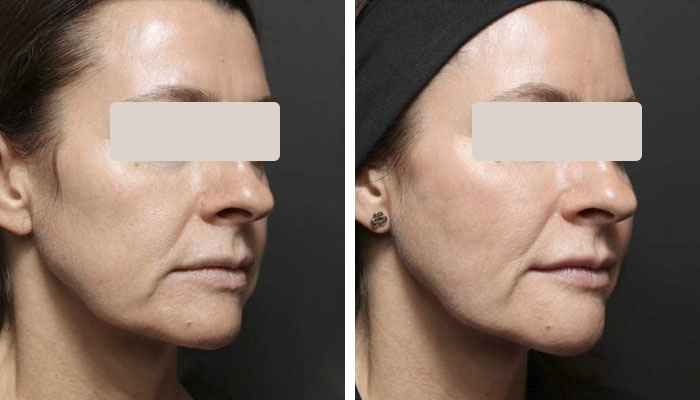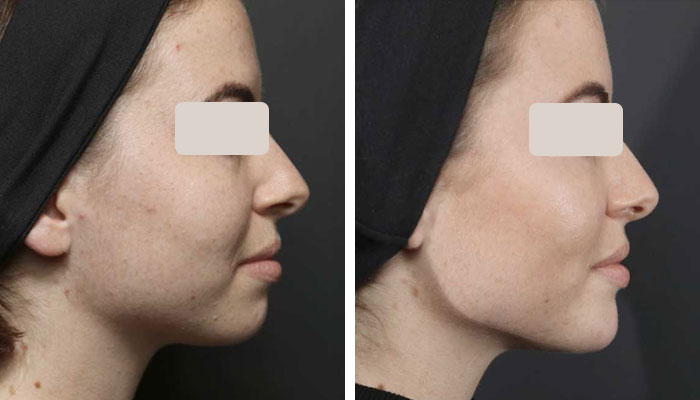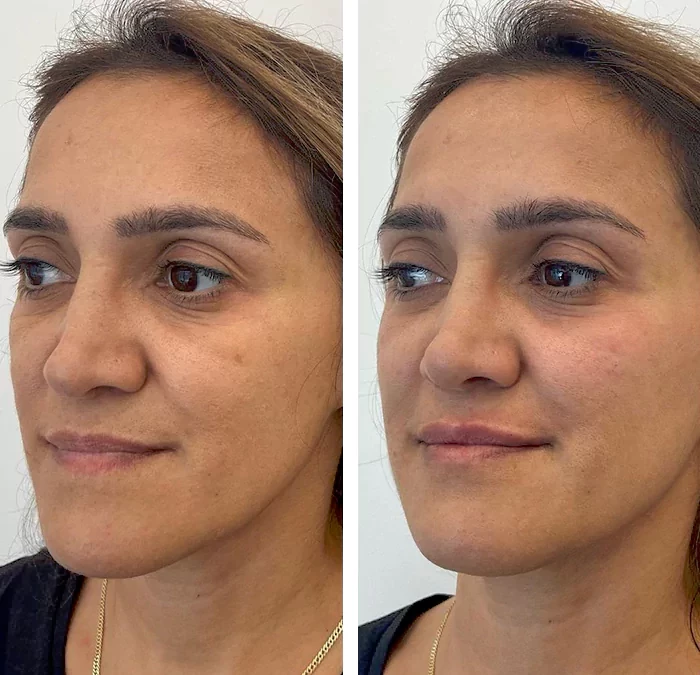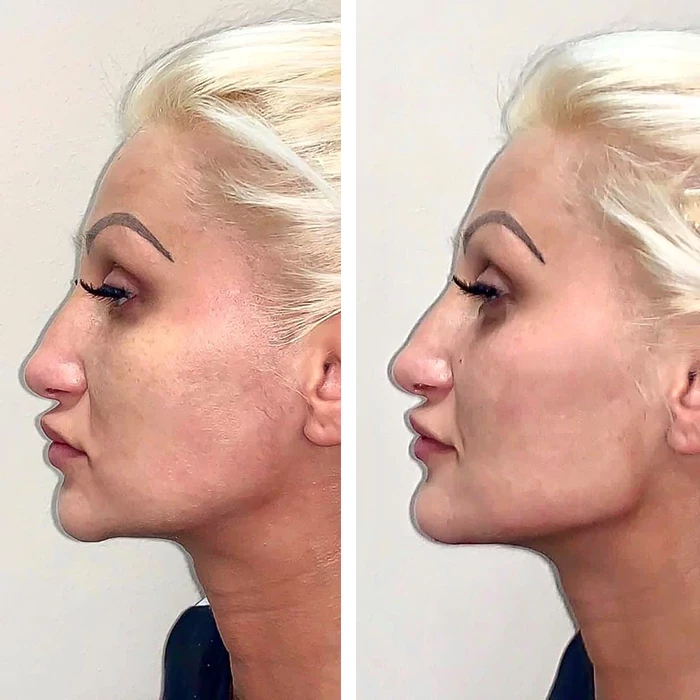What is a cheek filler procedure?
Cheek filler, also known as cheek augmentation or cheek enhancement, is a cosmetic procedure that involves injecting dermal fillers into the cheeks to add volume, contour, and enhance the overall appearance of the face. The dermal fillers used for cheek augmentation are typically made of hyaluronic acid, a naturally occurring substance in the body that adds volume and hydration. The longevity of cheek fillers can vary depending on the specific product used, individual metabolism, and lifestyle factors. Generally, results can last anywhere from 9 to 18 months before requiring touch-up treatments.
Benefits of cheek filler
Cheek filler procedures are performed for various reasons, including:
- Volume restoration: As we age, we naturally lose volume in our cheeks, leading to a sunken or hollowed appearance. Cheek fillers can restore lost volume, adding fullness and a more youthful contour to the cheeks.
- Facial balance and symmetry: Well-defined and proportionate cheekbones contribute to facial balance and symmetry. Some individuals may naturally have asymmetrical or underdeveloped cheeks. Cheek fillers can help correct these issues, creating a more balanced and harmonious facial appearance. They can help enhance and define the cheekbones, improving facial harmony.
- Contouring and shaping: Cheek fillers can be used to reshape and contour the cheeks, creating a more sculpted and defined appearance. They can add structure and definition to flat or less prominent cheeks.
- Rejuvenation: Cheek fillers can help rejuvenate the face by reducing the appearance of fine lines, wrinkles, and sagging skin in the cheek area. By adding volume, the skin becomes smoother and firmer, giving a more youthful appearance.
How a cheek filler procedure is performed
The cheek filler procedure is typically performed in a healthcare professional's office under local anesthesia. In general, a cheek filler procedure can typically be completed within 15 to 30 minutes and involves the following steps:
- Consultation: The process begins with a consultation where you discuss your goals, concerns, and medical history with the healthcare professional. They will assess your facial structure and determine if you are a suitable candidate for cheek fillers.
- Pre-treatment preparation: Before the procedure, the healthcare professional may apply a topical anesthetic or administer a local anesthetic to ensure your comfort during the treatment. They will also clean the treatment area to maintain proper hygiene.
- Marking and mapping: The healthcare professional may mark the injection points on your cheeks to guide the placement of the filler. They will assess your facial anatomy and determine the optimal areas for adding volume and contour.
- Injection process: Using a fine needle or cannula, the dermal filler is injected into specific areas of the cheeks. The healthcare professional will strategically place the filler to achieve the desired volume and contour. The number of injections and the amount of filler used will depend on factors such as your facial anatomy, desired results, and the type of filler being used.
- Massage and assessment: After the injections, the healthcare professional may gently massage the treated areas to ensure even distribution of the filler. They will then assess the results and make any necessary adjustments.
- Recovery and aftercare: Cheek filler procedures typically have minimal downtime. You may experience mild swelling, redness, or bruising at the injection sites, but these usually resolve within a few days. The healthcare professional may provide post-treatment instructions, such as avoiding strenuous exercise, excessive heat, and certain medications that can increase the risk of bruising.
It's important to have the cheek filler procedure performed by a skilled and experienced healthcare professional. They will have the expertise to assess your facial structure, determine the appropriate amount and placement of filler, and ensure your safety and comfort throughout the process.
How to prepare
To prepare for a cheek filler procedure, follow these general guidelines:
- Consultation: Schedule a consultation with a qualified healthcare professional who specializes in dermal fillers. During this appointment, discuss your goals, expectations, and any concerns you may have. Provide your complete medical history, including any allergies, medications, or previous cosmetic procedures.
- Research and choose a reputable provider: Take the time to research and choose a reputable healthcare professional who has experience and expertise in performing cheek filler procedures. Look for certifications, qualifications, and positive reviews from previous patients.
- Avoid blood-thinning medications: A few days before the procedure, your healthcare professional may advise you to avoid medications or supplements that can increase the risk of bleeding or bruising. These may include aspirin, nonsteroidal anti-inflammatory drugs (NSAIDs), vitamin E, fish oil, and herbal supplements. However, always follow your healthcare professional's specific instructions regarding medication adjustments.
- Avoid alcohol and smoking: It is generally advised to abstain from alcohol and smoking for a few days before the procedure, as they can increase the risk of complications and affect the healing process.
- Hydrate and moisturize: Keep your skin well-hydrated by drinking plenty of water and using a moisturizer regularly in the days leading up to the procedure. Hydrated skin can help optimize the results and minimize potential side effects.
- Follow pre-treatment instructions: Your healthcare professional will provide you with specific pre-treatment instructions that you should follow. This may include avoiding certain skincare products, makeup, or sun exposure on the day of the procedure. Adhering to these instructions helps ensure a successful and safe treatment.
- Plan for recovery: While cheek filler procedures typically have minimal downtime, it is still advisable to plan for some recovery time. You may experience mild swelling or bruising, so consider scheduling the procedure when you can take a few days off work or social activities, if possible.
- Arrange transportation: Depending on the type of anesthesia used, you may need to arrange for transportation to and from the appointment, as you may be advised not to drive immediately after the procedure.
It is important to note that these are general guidelines, and your healthcare professional may provide specific instructions tailored to your individual needs. Always consult with your healthcare provider for personalized pre-treatment instructions and to address any concerns you may have.
What are the recovery and aftercare like?
After a cheek filler procedure, it is important to follow proper recovery and aftercare instructions to ensure optimal healing and minimize potential complications. Here are some general guidelines for recovery and aftercare:
- Immediate post-treatment care: After the procedure, your healthcare professional may apply an ice pack or provide cold compresses to help reduce swelling and discomfort. They may also recommend over-the-counter pain relievers to manage any mild discomfort. Avoid touching or rubbing the treated area to prevent infection.
- Avoid strenuous activities: It is advisable to avoid strenuous exercise, heavy lifting, or activities that may increase blood flow to the face for at least 24-48 hours after the procedure. This can help minimize swelling, bruising, and potential complications.
- Minimize sun exposure: Protect your skin from excessive sun exposure by wearing a broad-spectrum sunscreen with an SPF of 30 or higher. Sunscreen should be applied even if you are not directly exposed to sunlight, as UV rays can still penetrate through windows. Sun protection helps prevent hyperpigmentation and protects the treated area during the healing process.
- Be mindful of facial movements: Avoid excessive facial movements, such as chewing gum or making exaggerated facial expressions, as this can potentially impact the distribution and longevity of the filler.
- Avoid certain medications and supplements: Some medications and supplements, such as blood thinners and anti-inflammatory drugs, can increase the risk of bruising or bleeding. Follow your healthcare professional's instructions regarding the use of these medications or supplements.
- Be patient with swelling and bruising: Swelling and bruising are common after a cheek filler procedure but typically resolve within a few days. You can apply a cold compress to the treated area to help reduce swelling. If you experience significant or prolonged swelling or bruising, contact your healthcare professional.
- Follow-up appointments: Your healthcare professional may schedule a follow-up appointment to assess the results and address any concerns you may have. Attend all scheduled follow-up appointments to ensure proper monitoring of the healing process.
It's important to note that recovery and aftercare instructions may vary depending on the specific cheek filler procedure, the type of filler used, and individual circumstances. Always follow the specific guidelines provided by your healthcare professional for your unique situation.
Risks and side effects
While cheek filler procedures are generally considered safe, there are some potential risks and side effects that you should be aware of. These can vary depending on individual factors, the specific filler used, and the skill and experience of the healthcare professional. Some common risks and side effects of cheek filler procedures include:
- Swelling and bruising: It is common to experience mild swelling and bruising at the injection sites after the procedure. This typically resolves within a few days, but in some cases, it may persist for a longer period.
- Redness and tenderness: The treated area may appear slightly red and feel tender for a few days after the procedure. This is a normal reaction and should subside on its own.
- Allergic reactions: Although rare, some individuals may have an allergic reaction to the filler material. Symptoms may include itching, redness, rash, or swelling. If you experience any unusual or severe reactions, seek immediate medical attention.
- Infection: There is a small risk of infection at the injection site. It is crucial to follow proper aftercare instructions, maintain good hygiene, and report any signs of infection (such as increased pain, swelling, or pus) to your healthcare professional.
- Granulomas or nodules: In rare cases, small lumps or nodules may form under the skin at the injection sites. These can sometimes be felt or seen and may require further treatment or removal.
- Asymmetry or uneven results: While efforts are made to ensure symmetrical and balanced results, there is a possibility of slight asymmetry or unevenness in the cheeks. This can usually be adjusted or corrected during follow-up appointments.
- Vascular complications: In rare instances, the filler material may inadvertently be injected into a blood vessel, leading to complications such as skin necrosis (tissue death) or vision changes. This is a serious but extremely rare complication that is minimized by the expertise of the healthcare professional.
It's important to discuss these risks and potential side effects with your healthcare professional during the consultation. They can provide you with personalized information based on your specific circumstances and help you make an informed decision.
If you experience any unexpected or concerning symptoms after a cheek filler procedure, it is important to contact your healthcare professional promptly for evaluation and appropriate management.
Cheek filler cost
The cost of a cheek filler procedure can vary depending on several factors, including the geographic location, the expertise of the healthcare professional, the type of filler used, the amount of filler required, and any additional fees associated with the clinic or facility. Here are some general cost considerations:
- Geographic location: The cost of cheek filler procedures can vary significantly depending on the region or city where the procedure is performed. Generally, larger cities and areas with a higher cost of living tend to have higher prices for cosmetic procedures.
- Healthcare professional's expertise: The experience, qualifications, and reputation of the healthcare professional performing the procedure can influence the cost. Highly skilled and renowned professionals may charge higher fees for their services.
- Type of filler used: Different types of fillers have varying costs. Some fillers are more expensive due to their composition, longevity, and brand reputation. Your healthcare professional will recommend the most suitable filler for your specific needs and goals, considering factors such as desired results, safety, and cost-effectiveness.
- Amount of filler required: The amount of filler needed to achieve the desired results can impact the cost. The volume of filler required will depend on factors such as your facial anatomy, the extent of volume loss or augmentation desired, and the healthcare professional's assessment.
- Additional fees: Additional costs may include consultation fees, facility fees, and follow-up appointments. These fees can vary depending on the clinic or facility where the procedure is performed.
It is important to note that costs for cheek filler procedures can range from a few hundred to several thousand dollars. To get an accurate estimate of the cost, it is recommended to consult with a qualified healthcare professional who can assess your specific needs and provide a personalized quote.
During your consultation, discuss the cost breakdown, payment options, and any potential financing or insurance coverage that may be available. Remember to prioritize the expertise and safety of the healthcare professional over cost when making your decision.
Cheek filler alternatives
If you are considering alternatives to cheek filler procedures, there are several options available to enhance and rejuvenate the appearance of your cheeks. These alternatives include:
- Fat transfer: Fat transfer, also known as fat grafting or autologous fat transfer, involves harvesting fat from one part of your body (such as the abdomen or thighs) through liposuction and injecting it into the cheeks. This procedure can provide natural and long-lasting results, as your own fat cells are used.
- Cheek implants: Cheek implants are a surgical option for cheek enhancement. During this procedure, solid silicone implants are placed over the cheekbones to add volume and improve contour. Cheek implants are a permanent solution but require surgery and recovery time.
- Thread lifts: Thread lifts involve the insertion of dissolvable sutures with tiny cones or barbs into the cheeks to lift and tighten the skin. This procedure stimulates collagen production and provides a subtle lifting effect. Thread lifts are minimally invasive and have a shorter recovery period compared to surgical options.
- Facial exercises and massage: Regular facial exercises and massages targeted at the cheek area can help improve muscle tone, circulation, and lymphatic drainage. While these methods may not provide significant volume enhancement, they can help improve muscle definition and overall skin appearance.
- Makeup techniques: Makeup can be a non-invasive way to enhance the appearance of your cheeks. Using contouring techniques, highlighting, and blush application, you can create the illusion of higher cheekbones and added volume.
It's important to note that the effectiveness and suitability of these alternatives can vary depending on individual factors, desired results, and the advice of a qualified healthcare professional. Consulting with a knowledgeable healthcare professional will help determine the most appropriate options for your specific needs and goals.
Ultimately, the choice of alternative will depend on factors such as your desired results, budget, tolerance for invasiveness, and recovery time. Discussing these options with a healthcare professional can help you make an informed decision that aligns with your preferences and expectations.
FAQ
What should I consider when choosing a healthcare professional for cheek fillers?
Consider their expertise, qualifications, experience with cheek fillers, patient reviews, and before-and-after photos of previous procedures to ensure they can achieve your desired results safely.
How can I ensure my cheek fillers look natural?
Discuss your aesthetic goals clearly with your healthcare provider, choose a qualified professional skilled in achieving natural-looking results, and follow their recommendations on the type and amount of filler.
Can cheek fillers be reversed if I don’t like the results?
Yes, fillers made from hyaluronic acid can be dissolved using an enzyme called hyaluronidase, allowing for adjustments if you're unsatisfied with the initial outcome.
What activities should I avoid after getting cheek fillers?
Avoid strenuous exercise, excessive heat (like saunas or sunbathing), and alcohol consumption for at least 24-48 hours to minimize swelling and bruising.
Are cheek fillers a good option for everyone seeking facial rejuvenation?
Cheek fillers are suitable for many people looking to restore volume or enhance facial contours, but a consultation with a healthcare professional is essential to ensure it's the right choice for your specific needs and health status.

